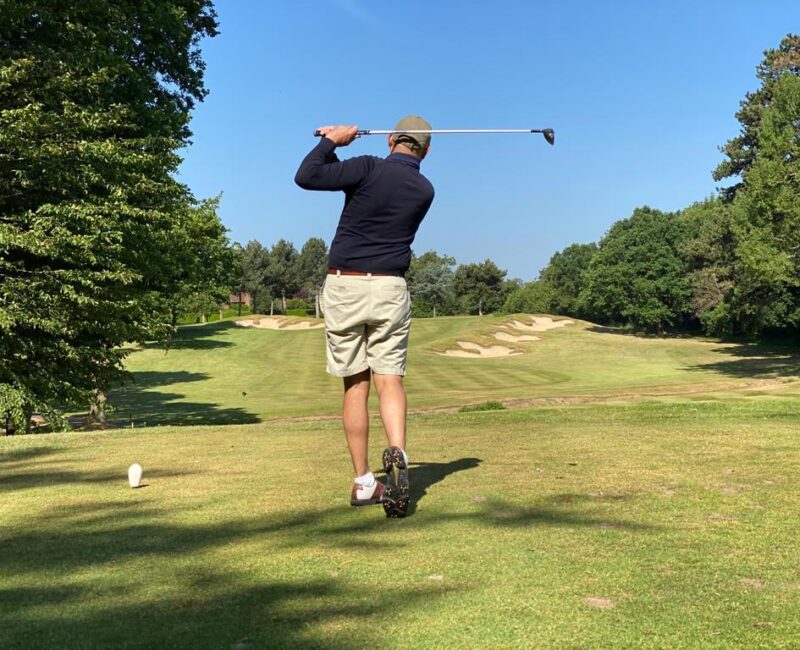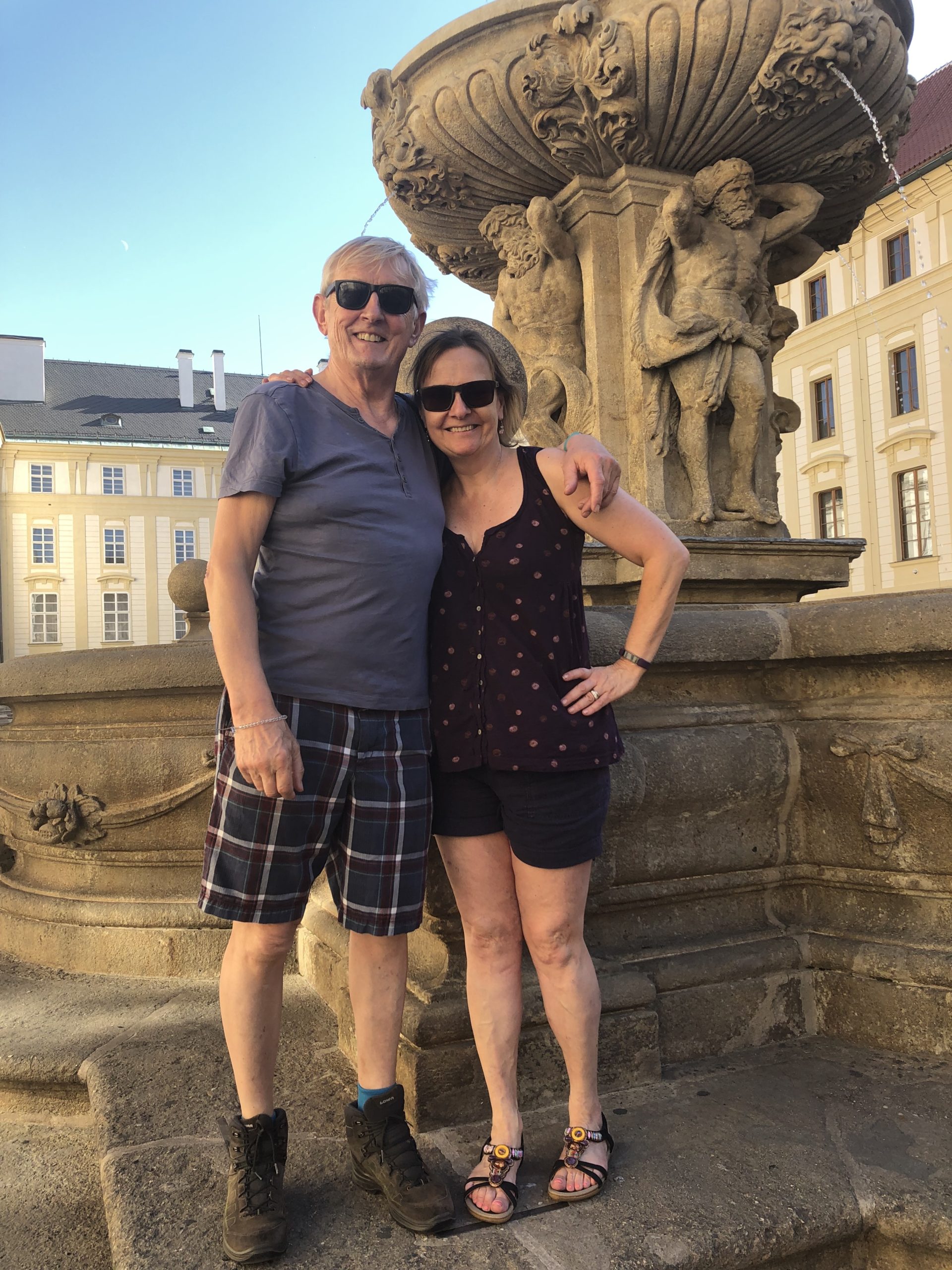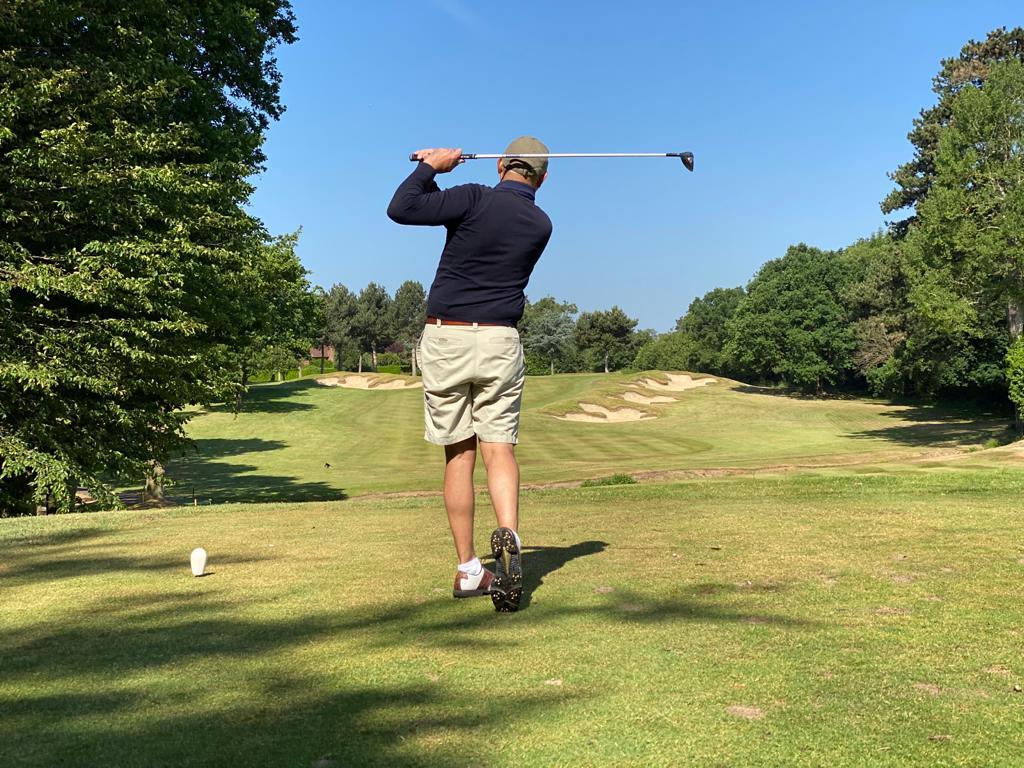
Farhad playing the 3rd hole of Stoke Park
This week, we’re talking golf with the editor of NetJets Magazine and the founder and CEO of House of Heydari. Having covered the game professionally and been around it since childhood, he explains why it is more than just a game.
Peter Welcome to our travel podcast. We’ve spent half a lifetime exploring every corner of the world.
Felice So we want to share with you some of our extraordinary experiences and the amazing people we’ve met along the way.
Farhad An alligator that literally just came out of this water hazard – frightened the bejesus out of me. I was scared shitless.
Peter Yes, you’ve guessed it – global golf – that’s what we’re talking about this week. Our guest is renowned golf commentator, Farhad Haydari. Farhad’s a leading authority on the game, no mean amateur player himself. Not many of us can shoot 72 at St Andrew’s. Farhad, golf has been a huge part of your life since you were a small child. Where did it begin for you?
Farhad Peter, it began for me when I was about 13 years old. My parents were living at the time, as they are now, in a place called Westchester County, which is just north of New York City. It’s the Surrey of New York City, if you will, it is dotted with golf courses and some incredible golf courses, including down the road from Winged Foot Golf Club, which just hosted the US Open. And so having had this incredible tableau, if you will, of championship golf courses, it was natural for me just to get out there and just sort of hit the ball.
I had a huge amount of tennis aptitude when I first started, but the problem with tennis was that you needed to find the partners to play with of the same competent level, whereas with golf you could play with whoever happened to walk up.
Peter Can you remember that first time you played golf?
Farhad The first four or five times that I played it was at a driving range because of course, some of these rather more elite golf courses and golf clubs didn’t like to have a young 13 year old showing up and taking divots out of their beautifully manicured turf.
So I was on the driving range for a good long while before I made my first foray. And I remember exactly where I was. It was a place called Ridgeway Country Club, which is sadly no longer in existence, as unfortunately that’s what’s been happening in the States. A lot of these golf courses have been going under, properties have been changed into schools and the like. But yes, it was Ridgeway Country Club in White Plains, New York, where I played my first round of golf.
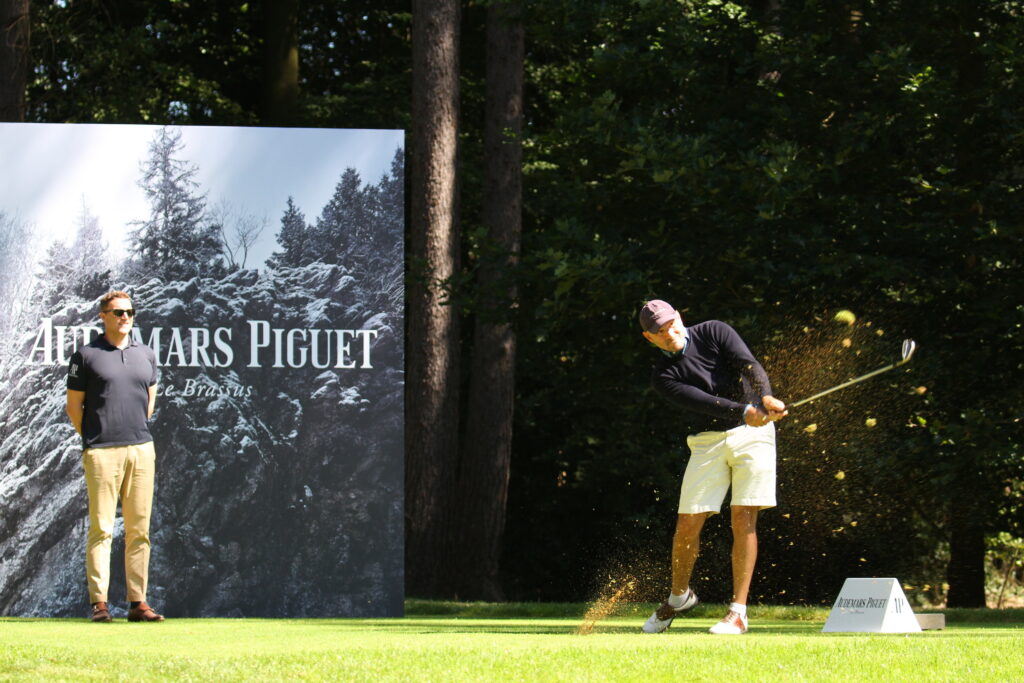
Felice So were your parents players as well?
Farhad They were not. In fact, my parents have no sporting aptitude whatsoever.
Felice And golf is one of the most popular sports in the world, isn’t it? Sixty million people around the world play regularly, so it’s very popular.
Farhad I call it a game, but a lot of people would take exception with that. They do call it a sport and at the highest levels of the game, it is a sport. You know, you’re walking a considerable amount of distances every day, the mental pressure is huge. I mean, if you play golf at a competitive level, which I have done on an amateur level, you play 18 holes and, with the mental concentration, you’re absolutely shattered. Whereas you could go for a 25-mile run and you’d feel more energetic after that.
So golf is a taxing mental game, but it’s a great game and it gets people out and it’s a social game and you’re able to deduce the, how shall I say it, the moxie of a person after four and a half hours play with them, you really get a measure of who they are and how they comport themselves, both from a sportsman standpoint, but also from a human standpoint.
Felice So you won a golf scholarship to university?
Farhad So I did. It was more of a country club than a university – it was a college up in New Hampshire. And I played a lot of golf up there as well as tennis. And there were a lot of more adept competitors that we had on the team than I was. But I played a huge amount of golf in college. And then I had the great fortune of covering the PGA Tour. So I was travelling around with the professionals for a while and making their acquaintances long before social media and the intrusiveness of cameras and all that. And so we were able to hang out with these guys in the locker room and take away some lessons from them and travel with them and go to wonderful, wonderful places and see the world. And my history with golf just sort of snowballed by complete happenstance.
Felice So how long did you do that for the PGA?
Farhad For four years.

Felice You must have met lots of notable players?
Farhad Absolutely. I mean, I travelled with Nick Faldo down to Jamaica and he and I were really well acquaintanced, and Fred Couples. And I became quite friendly and there were many, many others.
And again, this was this this was in the day where there wasn’t that whole ‘gotcha’ mentality where everything was ending up online and so they could let their hair down and they could be more extemporaneous and speak about things which, of course, now they would not be able to do because they’re all so guarded and shielded. And back in those days, there wasn’t this whole level of of a team, if you will. All golfers, professional golfers nowadays, have a team, whether it’s a sports psychologist or a nutritionist or a trainer. And they travel around in teams and on private jets.
Back in the days, they were just showing up in a Winnebago, an extended van. And, you know, they’re changing the diapers of the kids off the back and taking their shirt off – it was a completely different game. And so the journeyman who were on the tour were much more down to earth. Everybody from John Daly to the rest of them were much more amenable to chatting with people that they saw were part of the firmament of golf even though we were on the outside of the ropes, as they like to say, covering the game from the outside in.
Felice So was there anything in the characters that they had in common? Is there something that makes a champion golfer?
Farhad Well, there’s a huge difference between club golfers, let’s say, club professionals and touring professionals, and that’s the mental game. I mean, most of them can hit a ball far and long and straight and have the aptitude to be able to play the game to a pretty high standard. But what separates the elite golfers, the professionals, from the club players, if you will, is the mental game – and that incredible ambition and drive that they all seem to share, that they can conquer the world and they can absolutely conquer the field, i.e. their competitors during a given week.
Peter So is there one great champion who stands out for you?
Farhad Well, I’ve been very, very lucky, Peter, to have met and spent a lot of time with with most of them. And Jack Nicklaus and I spent a fair bit of time together over the years. And he was not only a gentleman, and he remains a gentleman, he was the first of the modern day golfers to parlay his on-course successes, which were innumerable and unimpeachable, to off the golf course.
So he created a whole design, architectural design, element. He created his own line of clothing and branding, and many others followed – Greg Norman with his Great White Shark Enterprise. But increasingly, the game took sort of a pivot to off the golf course. What would you do when you were a little bit old and frail and you weren’t able to hit the ball as long as the other competitors could do? And how were you going to leverage your notoriety off the golf course?
And so what happened was some of these notable golf professionals ended up becoming ambassadors for the game, taking the game to regions and countries and places that didn’t have golf. So, for example, Greg Norman very famously went to Brunei for the first time and created a golf course there. He’s the first golfer who developed a golf course on mainland China. Nick Faldo also did the same thing. And Jack Nicklaus, of course, was in the vanguard of that – he started developing a very, very important and sophisticated golf course architecture, a consultancy and firm. And his two sons got involved with that as well.
So it was all about how do you make the game much more accessible to the rest of the world, taking it away from the British Isles and the US where it was thriving, and get it more active in Europe, in places like France and Italy that didn’t have the game to a level that we now have.
Peter So presumably the whole process of golf course architecture is incredibly sophisticated and difficult. How do you go about taking a bit of land and just turning it into a championship golf course? I mean, that’s not easy, is it?
Farhad It’s not. But these guys have the vision and the vision that they have is incredible. I mean, back in the day, the heyday, the golden age of golf architecture, which started in the 20s and 30s. You had people, historically significant golf architects like Harry Colt and Alister MacKenzie in the UK. And then you had people like A.W. Tillinghast and Donald Ross, who were from British extraction but they went to the US. And they were met by developers and proprietors who said:
‘Listen, I’ve got this piece of land, can you see a golf course?’ And of course, the pieces of land – we didn’t have the population density that we now have in certain parts of the world – so they were able to mould these incredible parcels without having to move too much land, as they call it. And so it was a much easier proposition, let’s say, than it is now where we’re all hemmed in and land is much more expensive. But, you know, they have their artists and they have this incredible vision.
And nowadays you have this next generation of architects, everybody from Tom Fazio to Robert Trent Jones Junior: Bobby, who was the son of the original. And then, of course, players became architects, everybody from Greg Norman to Nick Faldo to, as I mentioned, Jack Nicklaus. And now you have this next generation of younger golf architects who are coming on the scene, who have never played the game professionally, but they have a great eye for it. Everybody from Gil Hanse to Tom Doak to Ben Crenshaw, who, of course, played with his partner Coore.
So you have these golf architects who are being sought after by proprietors who are, let’s say, much more foresighted than a lot of other people are and they can see a particular parcel of land and they can say: ‘You know what, I want this to be turned into a golf course that is going to last two or three hundred years,’ as some of these original classics have.
Felice So it’s a particular type of land that’s good for golfing. I mean, like desert or mountains or seaside links?
Farhad Well, as it happens, all those places are particularly great for golf courses because of how far agromics has come along. You know, back in the day, you couldn’t create a lush, grassy golf course in the desert, but now you can – technology has come such a long way. Seaside golf courses, coastal golf courses, links golf courses, as Peter just mentioned, these are the most heralded, of course, but a lot of people don’t want to give those up.
And the most spectacular, notable seaside golf courses have been opening on the Pacific Northwest of the US, as well as in Nova Scotia and some in New Zealand as well. But nowadays you can pretty much develop a golf course anywhere. And some of those desert courses, which a lot of people find tricked up because they have water fountains and waterfalls, and carries over water – all of which are artificial – look spectacular, under great challenge for the game of golf, but they’re not as true to the essence of the game as some would have you believe.
Peter So we spend it on nice to you to what are your favourite courses in the world you’ve played at or spectated at.
Farhad Well I’ve been very, very lucky because I’ve played some of the most incredible golf courses in the world everywhere from Cypress Point, which is one of the golf courses of Pebble Beach, to all the ones of St Andrews and places in Asia. The one that really does stand out for me is a place called Pine Valley in New Jersey, which many people say is the most private of all the golf clubs in the world, and it is. I’ve played Augusta National, which is a great golf course, and many, many others.
I’ve played one which I’ll never forget, called Camp Creek down in Destin, Florida, which for me just stood out because it was so beautiful and so much fun to play – lots of water carries and the prevailing trade winds. But again, places in Hawaii, I mean, there’s so many incredible golf courses in multifarious locations all around the world. And then there are these destinations that are popping up where one golf course gets developed and then the developer says: ‘These avid 36-a-day types, as we like to call them – golfers who play two rounds a day – we need another golf course for them.’
And so what happens is you have a cluster of golf courses that develop in random places in the world. So you now have that obviously in St Andrews – they just opened a new golf course in St Andrews this year. But you have it also in the Midwest of America and you have it down in Sicily: Verdura, where there was one golf course and Sir Rocco Forte decided to attract and inveigle the keen golfers: ‘Let’s put in another golf course.’
And then there’s another place in Ingres, Costa Navarino – it’s a resort that already has two golf courses and they’re building two more. So if you can create a destination, you can create a cluster of golf courses that keep the keen golfer engaged and enticed, you can spend a week there and be really engaged with the golf.
Felice So does that mean that a keen golfer would get bored playing the same course every day?
Farhad Yes. I mean, you know, club golfers, higher handicappers do play the same golf course every day. You know, they’re a member of a golf club and they go there and they play on Wednesdays and Saturdays and Saturdays and Sundays, whatever the case may be. But there’s a whole class of golfers who want to test their game on these beautiful, totally different tableaux of golf.
So they will travel far and wide to put their game through the paces. And that could be anywhere from a links course, as Peter mentioned, to a desert course or to whatever the case may be. And the great thing about golf is that it bridges all these different things: architecture and the arts to geography and topography, to location and travel. And so it’s a great proposition, if you will, for somebody who has caught that bug, let’s say.
Felice Yes, because most golf clubs have something else for the non-golfer to do, like some of them might have a swimming-pool or tennis courts.
Farhad So, yes, the country clubs. And a lot of purists say: ‘I don’t want to be a member of a country club where you have a tennis club, tennis courts and paddle courts and the kids are swimming, I want to be a member of a golf club.’
But you know, I believe that what you should do is open up the game to more and more people. And so if you have a country club and the kids are jumping in the swimming-pool, but then can come out and play with their father a couple of holes, or walk and be around the game, that opens the game to more and more people, because as you mentioned early on, Felice, there are at least there are 60-odd-million people playing the game, but unfortunately, over the last few years – Covid issue notwithstanding – many of these golf courses in less travelled parts of the world have been closing.
So the municipal golf courses, those which are run by local government as a service, as a recreational element for local people in population spots, whether it’s Los Angeles or New York City, et cetera, are closing – because, as you know, with golf there’s a huge amount of overhead as it pertains to operations and maintenance and the rest of it. And so it’s not a maintenance-lite pursuit where you’re going to put in a tennis court and you make sure it’s painted and the net’s not raggedy. With golf, it really does need a huge amount of care and attention. And so a lot of these golf courses are unfortunately going to the wall. As I mentioned, Ridgeway Country Club up in Westchester north of New York City, where I played my first game of golf, has been turned into a French school.
Felice Do golf courses come up against problems with the environment, with people who are anti golf courses because of the water and things like that?
Farhad Yes they do, Felice. Because what has happened in the last few years is obviously the environmentalists have seen that there is a huge amount of pollution and runoff from golf courses with the pesticides that they use. However, also concurrent with that, golf courses and the superintendents who run the golf courses have become much more creative in the ways that they’re applying the chemicals to make sure that they are in keeping with the local surroundings.
And again, going back to the technology factor, there is a huge amount of technology that’s going into agronomy that is making golf courses much more sustainable, environmentally, than they used to be before. And so whether it’s introducing worms that can reseed grassy areas or whether you have wild run-off areas, or whether you have these natural grasses that can frame golf holes rather than the manicured grasses that you need, that would take a lot more pesticides and herbicides and the rest of it. Golf is becoming much more environmentally-friendly than it used to be, even though there are still to this day, I think perhaps rightly, perhaps wrongly, some detractors out there.
Peter Because there are quite a lot of golf courses in the world in wilder the places, particularly in Africa, where there are lots of natural hazards that you wouldn’t find in America or in Britain, say, like getting close to a crocodile on the green.
Farhad Absolutely. Or rattlesnakes or scorpions and the rest of it. I remember I was playing one time in Florida and there was an alligator that literally just came out of this water hazard. I won’t use an expletive because it’s a family podcast, but yes, I mean, it frightened the bejesus out of me. But no, in Australia, the rattlesnakes going around and cobras and the rest of it…because they’re out there. I remember playing this golf course in New Mexico on a Native American reservation called Tamaya Resort and I was going along with a professional at the time and he said to me: ‘Farhad, I wouldn’t foray too far from the edge of the fairway. We’ve got rattlesnakes here.’ I was like: ‘Okay, we’ll just leave that ball where it is and drop one here.’
Felice But when you saw the alligator coming out of the water hazard?
Farhad I was scared shitless to underscore and underline that. No, it was frightening and, if you Google ‘encounters of the wild kind on golf courses,’ you see it all the time. You know, people reaching in to try to get their ball out of the water hazard, not realising there’s a giant crocodile or alligator in there.
Felice I’ve never thought of that.
Farhad And then, of course, if you play in certain parts of the world up in the northeast of the US, you’ve got bears and cougars and the rest of them. I remember one time playing up in New Hampshire at my home course, which was called the Shattuck. And during deer-hunting season, you had to wear all orange golfing kit because, of course, you would stand out to the hunters because it was deer hunting season.
It was my freshman year I wasn’t dialled into this fact. And I’m playing the first hole, and between the first green and the second tee, this guy comes out of the woods in full camo gear, all black with a nightscope and a bow and arrow that could take out an 18-wheeler or a lorry and he just looks at me. He’s like: ‘Play well.’ He just crosses the fairway. And I’m like: ‘Oh, my God.’ So because, of course, in the deer hunting season, these people are murdering hundreds of animals. And I’m out there trying to hit a golf ball. So there were those perils as well.
Peter And you are becoming the prey, the target as well.
Farhad Well, let’s hope not. I mean, I’ve lasted this long, Peter, so I must be doing something right.
Felice So what about equipment and clothing? Do those change quite frequently?
Farhad Yes, equipment has changed considerably in the last 15 to 20 years to the dismay of many people. A lot of people think of the golf equipment for the squads that the manufacturers have made is rendering many of these golf courses that were created by the originals during the heyday of architecture and the golden years moot – because they are able to hit the ball further and really decimate these classic golf courses in a way that the architects could have never imagined.
And from some quarters, there are people who are trying to dial back how far a golf ball travels to make sure that these golf courses, that were beautiful and fantastic and are a challenge to most amateurs, are not rendered completely pointless. And of course, technology keeps moving on.
The golf clubs are becoming much more forgiving, which has made the game for amateurs much more pleasurable. Back in the day, you would have a hickory shaft with a persimmon head and you would be swinging it and the ball would bumble down the fairway. And now you’ve got titanium heads with graphite shafts that anybody can hit two or three hundred yards. And so the game is much more pleasurable, but there are some strides being made to to rein in some of the exceedingly powerful advances the technology has made.
And of course, then the equipment manufacturers have to adapt to all this. And equipment manufacturing is a very expensive proposition – everything from research and development to marketing etc. So we have seen that the number of golf brands, equipment brands, has shrunk and now we have a handful of major golf brands which are monopolising the golf sector.
And having said that, there are some people who are huge devotees of the game joining the ranks of golf manufacturers, most notably a gentleman by the name of Bob Parsons, who was the founder of GoDaddy, the web registration. And he was such a massively keen golfer that he decided he was going to pour in a huge amount of money to create his own golf brand.
So he launched a company called PXG – Parsons Xtreme Golf – a few years ago. And his golf clubs are absolutely brilliant and they’re very, very forgiving and they’re very expensive, unfortunately. But again, he’s joining the fray and saying: ‘You know what, there there is space for other manufacturers to be out there. And we want to join the top tier of said manufacturers.’
Peter But none of these strides, progress in the manufacture of equipment, help people like me standing in total fear on the first tee at Sunningdale on somewhere with a queue of people waiting to go behind me, knowing that it’s almost impossible for me to get that ball into the air in a straight line.
Farhad Well, Peter, you and I then need to go out for a full day clinic where I will rebuild your swing and, you know, the old adage goes, ‘We need to break you down to build you back up again.’ But before before too long, you’ll be hitting the soaring golf ball off the first tee down the middle of the fairway of Sunningdale old or new, you as the case may be, and you’ll vanquish those fears.
But, yes, seriously speaking, those ‘first tee jitters’, as they call them, are very well founded. I can’t remember how many times I’ve played with amateurs who get up there and they literally are shaking. And I’m like: ‘Dude, relax. It’s not brain surgery. You know, you’re not trying to remove a tumour, you’re just trying to hit a white golf ball.’
I’ve been very lucky that I’ve played in a boatload of pro-ams – and pro-ams for the listeners who don’t know, are the professional amateur days that precede the Thursday start of a tournament. And so you have sponsors who invite their top benefactors or friends of the tournament, friends of the brands, or sponsors to come and play a practice round with one of their pros.
And so the pros are getting the measure of the golf course before they play their tournament, starting on Thursday with a couple of practice rounds on Tuesdays and Wednesdays. And I played in a couple of those – most recently last year, the BMW championships at Wentworth with one of my mates, a professional golfer out of the UK called Paul Casey, who you may have heard of, with the head of Rolex as well as his agent. And we had 55,000 people out there lining the fairways.

Team Paul Casey during the pro-am of the BMW PGA Championship, Wentworth. Photo: © Golffile/Fran Caffrey
And my wife was walking along with us inside the ropes and she said: ‘How are you managing to do this? How are you managing not to shank it into the face of grandma sitting there? You’re used to it, but the people are petrified.’
And there are instances of amateurs, unfortunately, having an errant shot during a pro-am or on their Tuesday or a Saturday roll up at their local golf club. At the end of the day, if you don’t have that incredibly precise level of concentration over every golf shot, things are bound to go wrong because it’s such a finite. I mean, the ball is just sitting there. It’s not tennis where the ball is coming at you and you have to react. The ball is just sitting there and you’re just there with your own thoughts, with this thing staring at you and you’ve got to hit it. And it sounds simple, but as most golfers will tell you, it’s a lifetime pursuit and trying to do just that.
And you go out there and you try to do something different and watch something or you read something. Back in the day we used to read, put in a VHS of Jack Nicklaus’ Golf My Way to try to play the game. But nowadays, with YouTube and Instagram and the rest of it, so much information is out there to be able to make the game much more accessible, so that when you do go and stare at the white ball in front of you, your knees are not shaking and you can hit that soaring shot, Peter, into the air on the first tee at Sunningdale.
Peter I look forward to it.
Felice Well, you mentioned Wentworth. That’s where I came in, because my mother was a member. And so, throughout childhood, I went to Wentworth every weekend but I was never allowed to play. I had to stay by the swimming pool-in winter or in summer. And yes, sometimes I had to help caddy, but I was never allowed to play.
Farhad And that’s one of the one of the great disservices that has been done and was done to women for a great many years in the sphere of the game of golf, where women were subjugated to being sort of second place players, let’s say, at many, many golf clubs. And then, of course, there were the golf clubs that didn’t even allow female members and those that did had very restrictive times for when the female members could play and when women could go out.
And so it made it very, very difficult for women to get traction into a game which was naturally perfectly a fit for them. And so unless you allow a much more inclusive, let’s say, milieu for women to join and to play and to feel welcomed, you’re never going to have women in great numbers of a certain calibre being able to play the game.
But the Wentworth of yesteryear is a lot different than the Wentworth of today. The course is now under new ownership of the golf courses. Absolutely bonsai perfect and I’m very lucky that I get to to play there three or four times a year with friends who are members.
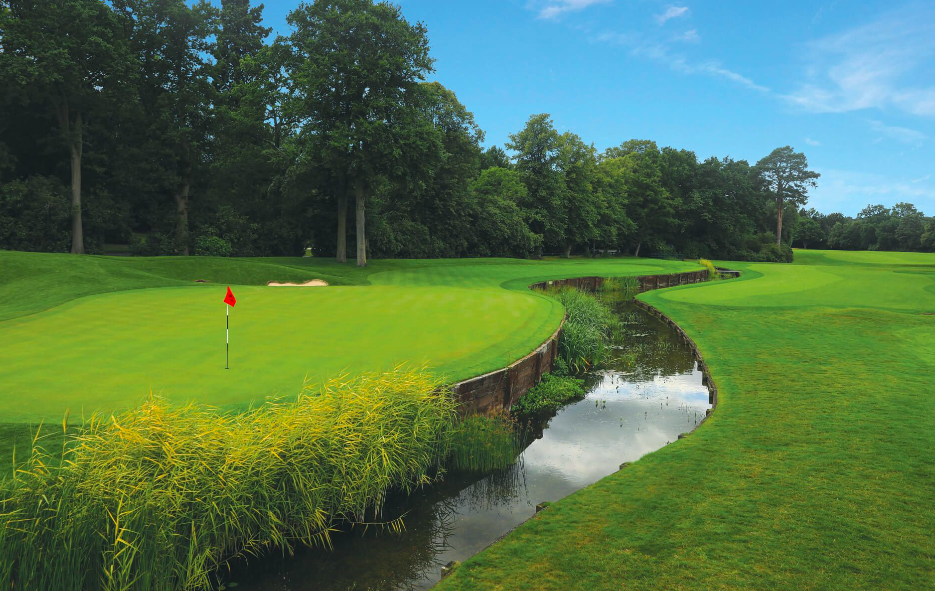
On the West course at Wentworth
Felice And do you think golf clinics are a good thing? Do they vary? Are some of them very good and some of them a waste of time?
Farhad They do vary. This is one of the great things about golf, is that you can go off and have a clinic or have a multi-day academy like we used to do back in the day with tennis. You know, back in the day when tennis was on the ascent, I used to go down to Florida and Chrissy Everett had her academy and Nick Bollettieri had the academy. And you learn about the game of tennis, but golf is less organised.
But most golf clubs and most golf resorts have a huge teaching program where they have their director of golf and they have a handful of pros who can teach the game. For example, Stoke Park just outside of London, which many James Bond fans will remember for the iconic golf scene in the movie Goldfinger, has recently debuted the David Leadbetter Golf Academy, where members as well as non-members are welcomed and offered world-class tuition on every aspect of their game. The five-star hotel, spa and country club boasts 27 championship holes and a whole roster of practice facilities to make it easier for higher handicappers to get a full all-round appraisal of their game.
And now, because of all the technology that we have, the game is with feedback, everything from telemetric to video to measuring everything from your ball speed to your dispersion rates, to your swing speed, to your positioning. And you can look at it and you have instant feedback, so it’s a lot less ethereal, it’s much more tangible and you can see what you’re doing right and what you’re doing wrong.
So learning has taken on a whole new dimension. And I would say you can learn a lot faster than you used to be able to reading a golf magazine, as we used to do back in the day, or trying to emulate Jack Nicklaus on an old VHS.
Felice How fit do you have to be to play golf?
Farhad As was demonstrated by my dear old friend, John Daly, who was a paragon of unhealthiness and obesity, you don’t have to be healthy at all. But in playing the game, it does make you a much more healthy individual, because if you’re walking, there are certain places in the world or the States, notably, where you play some of these longer destination golf courses and they insist on you taking a cart or a golf buggy just to keep the pace of play up.
But in a lot of other places: the British Isles, some places in Asia where walking is not only not frowned upon, but encouraged, you can become quite fit. But then you go to places like the Middle East, where if you’re playing during the day and it’s 110 degrees, you’ll have a heart attack and need a defibrillator. So there you’ll have to play the golf courses with a golf buggy or a cart. So it depends where you’re playing the game.
Peter Jimmy Connors once said to me that there comes a moment as a sportsman when just occasionally the ball coming across the net is the size of a football and you simply cannot go wrong. Have you ever had a round of golf when you felt like that?
Farhad I have. Jimmy, of course, was considered one of the best returners in the game of tennis until Andre Agassi and Jim Courier came along. And for golf, yes. The analogy that we make is that the hole looks the size of a bucket because everything you’re putting will drop in the hole and you have one of those outrageous days. I’ve been very lucky in the past couple of years that I’ve played some great golf. I was very lucky.
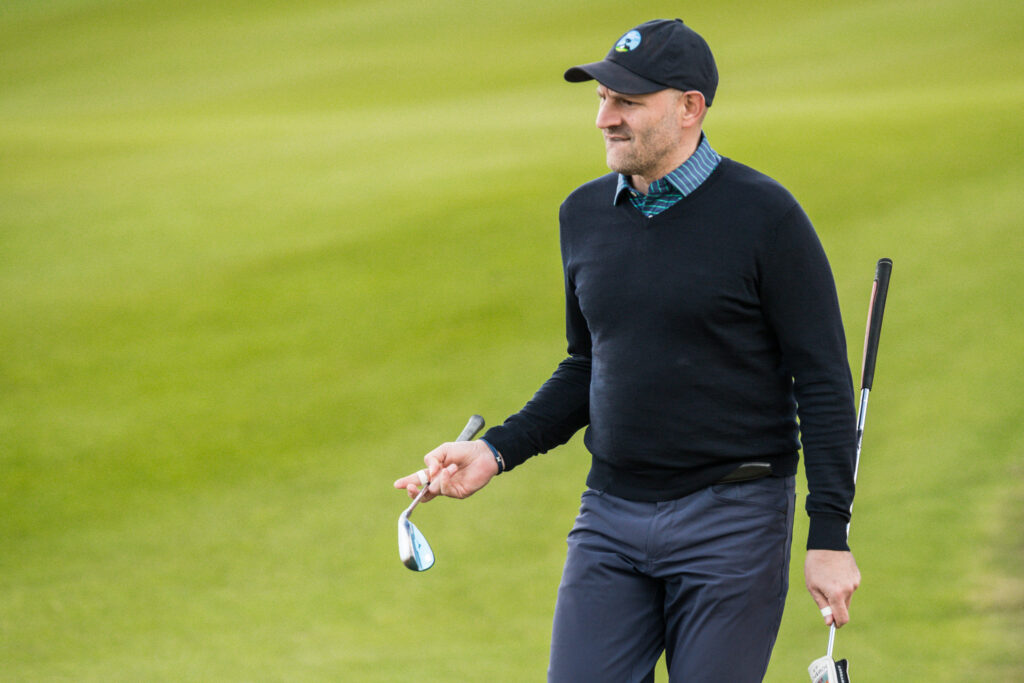
Farhad at the golf course
I was at the Dunhill Championship ProAm up in St Andrews and I shot 72 there. I’ve shot a couple of more rounds in the 70s and the last couple of months. So I’m very, very lucky in the sense that I’ve got my wits about me and I’m mentally in a place where I can relax and playing with a handful of great, great chaps that I play with on a weekly basis where we all comfortable. We’re not trying to be showy, and that level of comfort to brutality – if that’s even a word, a faux polysyllabic word – leads to you playing great golf because it puts you at ease. You’re not stressed out.
I remember one time playing a game of golf with a chap who, when we stood on the first tee, he said to me: ‘These are the last words we’ll exchange until the 18th.’ And sure enough, we didn’t speak at all for the 18 holes. And at the end of the 18 holes, he says: ‘That was a great game. Let’s do it again.’ And I’m thinking to myself, I don’t ever want to look at you and I don’t want to see you. In fact, I’m going to punch you. You know, he just took it so seriously.
Felice So you’re an editor and journalist as well, in the rest of your life when you’re not playing golf?
Farhad I’ve been an editor and a journalist. I’ve been very lucky in that I’ve had a multitude of different careers. In my current remit, I work very closely with NetJets, which is obviously the largest private aviation company in the world, producing magazines and content for them. But I also have my own consultancy, which is an entity called the House of Heydari. And it’s an entity that provides advisory services for C-Suite individuals, Blue-Chip companies on a whole slew of levels. It’s going from strength to strength. You’re listening to this so you should follow me on at Mr Farhad Heydari on Instagram, where there’s a lot of golf content, which you will be curious about.
Peter Can you just spell out your name?
Farhad FARHAD and the last name’s HEYDARI.
Peter Farhad Heydari many thanks for appearing on the show and we wish you the very best in the future with your golf and all your other projects.
Farhad Thank you very much indeed, Peter. It’s been great being on with you and Felice. Best of luck with the podcast, which we’ll all be listening and tuning into it.
Felice That’s all for now. If you’ve enjoyed the show, please share this episode with at least one other person! Do also subscribe on Spotify, i-Tunes or any of the many podcast providers – where you can give us a rating. You can also find us on Twitter, Facebook and Instagram. Stay safe and we’ll see you next week.
© ActionPacked Travel

- Join over a hundred thousand podcasters already using Buzzsprout to get their message out to the world.
- Following the link lets Buzzsprout know we sent you, gets you a $20 Amazon gift card if you sign up for a paid plan, and helps support our show.

